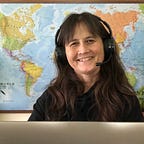A Guide to Nature Writing
The problem most students seem to have is that they see nature as “Other.” Nature is a tourist destination, a place on a map, something saved by buying and selling crunchy candy. They rarely understand that they themselves might actually be part of it.
- Christian McEwen & Mark Statman
The Alphabet of the Trees: A Guide to Nature Writing is a collection of twenty-nine essays by nature writers, poets, fiction writers, and educators. More than simply a collection of nature essays, The Alphabet of the Trees is a wonderful collection of ideas for the classroom and the field.
In their respective essays, contributors share their experiences teaching students how to write about nature. Contributors provide clear instruction, examples of student work, and plenty of inspiration to last an entire school year.
McEwen & Statman (2000) published this book for teachers because they wanted to change how nature is approached in the classroom. They explain that they want nature to be more than a collection of facts. Their book has so many wonderful ideas and so many different ideas. It is impossible to summarize them. Instead of attempting a blanket summary, I would like to provide a glimpse into the type of writing activities contributors share with teachers. Listed below is each contributor's name and the lessons and inspiration they invite teachers to bring into their classrooms.
- Gary Snyder — The power of language and observation.
- Matthew Sharpe — Ideas about how to lead a conversation about nature in an urban classroom.
- Susan Karwoska — Using children’s literature to explore nature in the city.
- Joseph Bruchac — Teaching the value of listening to connect with, and write about, nature.
- Sam Swope — How to write about common objects in many different ways.
- Eleanor J. Bader — How to write an advocacy essay.
- Kim Stafford — Recording the thoughts and words of children.
- John Tallmadge — Looking for wildness in the city.
- Mary Oliver — How to keep a notebook of felt experiences.
- Barbara Bash — Field sketchbooks in the city.
- Sarah Juniper Rabkin — Seeing through the eyes of a scientific illustrator.
- Clare Walker Leslie and Charles E. Roth — Nature journaling with school groups.
- Christian McEwen — Using the five senses to write about nature. Also, how to set up an ode to nature or any topic.
- Suzanne Rogier Marshall — How to transition from looking to writing.
- Holly Masturzo — How to encourage observation through discovery.
- Ann H. Zwinger — How to write a natural history essay.
- Carolyn Duckworth — Tools for exploring an animal and an issue.
- Mary Edwards Wertsch — How to write nature poems (specifically question poems).
- Michael Morse — Writing about nature using the senses and observing transformations in nature.
- Penny Harter — Lessons that address how to write about animals (grades 4–12).
- William J. Higginson — How to write haiku and linked poems (includes renku topics and guidelines for teachers)
- Cynde Gregory — A garden writing exercise that is a good lead-in to a unit about plants.
- Jordan Clary — Using nature imagery in poetry.
- Jack Collom — A wonderful collection of writing ideas for poetry.
- Terry Hermsen — An exercise in creative memory (poems to help humans recall what they have forgotten about Earth, Wind, Air, and Fire.
- Margot Fortunator Galt — Nature as teacher and guide (circle poems, writing about landscapes, seasons).
- Janine Pommy Vega — How to help students speak for something in nature (persona poems).
- Barry Gilmore — Exercises in naming things, observing, and describing.
- Carol F. Peck — An idea to incorporate writing with social studies curricula.
Contributors each include a list of resources at the close of their essays. Editors McEwen & Statman reorganize these resources and provide teachers with a rich bibliography of nonfiction books, fiction books, books about poetry, and books for children. They also provide a list of resource organizations and a short biography of each contributor.
Teachers, parents, naturalists, and others can use the ideas in this collection in many ways beyond the traditional classroom. Outdoor educators, naturalists, and interpreters will also enjoy this book.
Learn more about Christian McEwen at www.christianmcewen.com.
You can purchase The Alphabet of the Trees: A Guide to Nature Writing at Talaterra’s bookshop. A small amount of your purchase supports Talaterra and its initiatives serving environmental education professionals.
Originally published at ArtPlantae on August 3, 2013.
